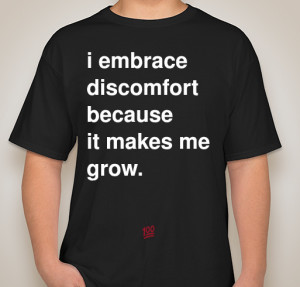 In my last post, I told you about why is it so important to choose to be uncomfortable so that you can use your “Human Brain” (your prefrontal cortex) to create what you want. I also told you that the more you practice this, the less uncomfortable it will get over time. But how do you “get good at” being uncomfortable when our natural tendency is to avoid discomfort?
In my last post, I told you about why is it so important to choose to be uncomfortable so that you can use your “Human Brain” (your prefrontal cortex) to create what you want. I also told you that the more you practice this, the less uncomfortable it will get over time. But how do you “get good at” being uncomfortable when our natural tendency is to avoid discomfort?
The answer is to change your mindset about discomfort and learn some new tools to help you practice. When I use the term mindset, I’m referring to a set of assumptions and beliefs you have about it. Which is just another way of saying your thoughts about it. Our Lizard Brain’s automatic response is often something like,
No way, this sucks, how can I feel better now?
It’s time to go work out but I am tired. The thought of all the physical effort is uncomfortable. So the Lizard Brain makes excuses and rationalizes,
Probably shouldn’t put the pressure on my knees today. I’ll wait one more day
Discomfort avoided!
Lizard Brain win!
So to change our thinking we have to use our Human Brain to observe the Lizard Brains’ excuses and label them by being really honest with ourselves. Then we have to call upon the Human Brain to override that excuse with a more powerful thought that will get us better results. And that takes effort and practice. That is a new skill that anyone can learn.
All learning and skill development takes time and practice. You are willing to put in that effort when something is important. I have a friend who will spend 3 hours shopping for a new pair of pants, but not spend 15 minutes working on her mind to create new thoughts. How important is that goal? She obviously wants to look good so she’s willing to spend time shopping because she thinks that is more comfortable. But what if she practiced the thought,
It will be so much easier to find pants that fit me if I spend 20 minutes on my leg lifts and squats 3-4 times this week. It may be uncomfortable to push myself at first but the more I practice, the easier it will get
The next tool in learning to embrace discomfort is to lean into it. I’ve talked about observing your automatic response. You have to notice it, observe it and then label it:
That’s my Lizard Brain wanting to be efficient.
Instead of resisting it, or tensing up against it, let yourself just accept it.
Okay, that’s what my Lizard Brain does. It’s normal. I’m normal.
There is tremendous relief in just accepting what is present in this moment and not fighting it. This acceptance, or leaning into it, allows you to move forward and choose a different response. But if you immediately go into resistance,
Oh no there it is again, I have to do battle with this part of me,
You change your energy. Now you’re less open to possibilities. So try acceptance:
Okay, that’s what my Lizard Brain does. It’s normal. I’m normal.
Now you are free to choose a different response. Instead of just resisting your discomfort, you can observe and allow it. Acknowledge this is uncomfortable (working out when I’m tired, saying no to dessert or a glass of wine, etc) but I can handle it. I can be uncomfortable to get what I want and it will be temporary and I will survive. And the more I practice it, the less uncomfortable it will get.
To summarize,
- Be willing to change your mindset and thoughts about discomfort.
- Learn to observe and label it
- Lean into it, accept it
- Acknowledge that it’s temporary, you won’t die and it will get easier
How do you think this could impact your relationships? What would change if you learned how to tolerate some discomfort and not react when you become uncomfortable?

